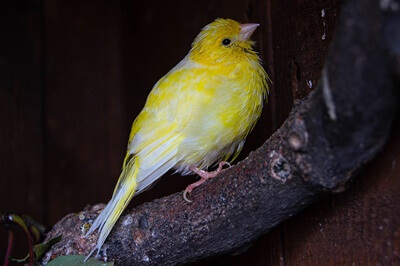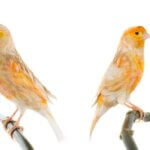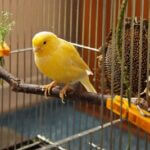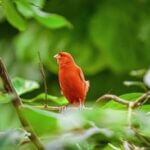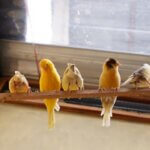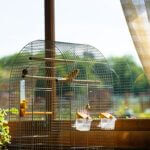Canaries perch, sleep, eat, and play while on their feet. Unlike other animals, they don’t lay down on their sides or backs to rest their legs. At the most, they take turns standing on one foot over the other.
So, it’s no surprise that canaries’ feet can experience a wide range of issues. Some foot problems are more serious than others, but in any case, prompt diagnosis and treatment will provide the best outcome.
Unfortunately, it’s difficult to determine if canaries’ feet are injured since they’re good at hiding pain.
Common Symptoms Of Foot Problems In Canaries
There are three symptoms of foot problems in canaries:
Swollen Foot
Swollen feet often mean that the area is inflamed, which can be due to injury or infection. Once the wound or infection is addressed, the swelling should subside.
Hot Feet
Canaries naturally run hotter than humans, so you’ll know that a canary’s feet are too hot when their temperature reaches 104 degrees F.
Also, feet that are very hot to the touch are symptoms of inflammation.
Limping
If your canary is limping, it may have an injury or one of the following issues:
- Improper diet, especially a lack of vitamin D
- Viral, bacterial, or fungal infection
- Illness and disease, especially kidney disease
- Tumors that affect nerves connected to the feet
- Arthritis
Common Canary Foot Problems
If your canary develops foot problems, you need to intervene. Without treatment, a canary may become lame and unable to stand or walk.
Here are five common canary foot problems with treatments:
1/ Claws Too Long
Wild canaries naturally wear down their nails. Gathering food and perching on abrasive surfaces keeps a canary’s claws at the appropriate length.
Unfortunately, this doesn’t always happen in captivity due to less activity. So, the provision of textured perches and preening behavior is usually enough to wear down any excess.
Signs that your canary’s nails are too long include:
- Abnormal perching position
- Moving less frequently
- Nails getting stuck in toys, clothes, and objects
- Sore spots on skin from scratching
Sometimes, a canary’s talons need to be trimmed. You can bring your canary to the vet for its first few trims, which will allow you to witness how to trim your canary’s nails.
Treatment
To prepare your canary for at-home clipping, do the following:
- Keep styptic gel on hand to staunch any bleeding.
- Wrap your canary in a small towel, if necessary.
When trimming, follow these steps:
- Use a nail clipper designed for birds, as human nail clippers often cause the nails to split.
- With one hand, hold the canary firmly around its sides.
- With your other hand, hold your bird’s head. Place your thumb on one side and middle finger on the other.
- Be firm enough so that the canary isn’t able to move its head freely.
- To clip the nails, allow your canary to grasp onto one of your fingers.
- Use your thumb to lift one nail, then clip.
- Avoid the quick. If you do cut into the quick, use styptic gel right away.
If your canary panics during the trimming, you should stop. Behaviors to watch out for include:
- Panting
- Moving too much
- Eyes rolling into the back of the head
Try again later, or get the process done at the vet or a groomer.
Prevention
Regular clippings are necessary for pet canaries. However, using perches of varying diameters will help a canary keep its nails trimmed.
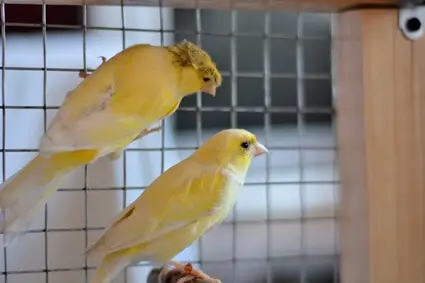
2/ Foot Injury
Canaries are skilled at hiding their discomfort, so don’t judge the severity of an injury by how a bird behaves. The chances are that your canary is in more pain than it lets on.
Canaries’ legs are prone to scrapes, cuts, breaks, and sprains. Injuries are often caused by the following:
- Getting caught on objects, like toys and cage bars
- Fights with other birds
- Picking and other forms of self-harm due to stress
Injuries to the feet can be hard to spot, so keep an eye out for the following behaviors:
- Limping
- Abnormal movement of the wings
- Lack of physical activity
If your canary displays the above symptoms, the chances are that it has been physically injured.
Treatment
If a canary is bleeding, you’ll need to perform first aid. Do this by applying firm pressure on the wound.
To clean wounds, use a dilute solution of antiseptic liquid. You can use warm salt water, 1% hydrogen peroxide, or store-bought antiseptics.
Don’t use creams or ointments, as these can get onto the feathers, which can stress out your canary.
Use a syringe to flush the wound with the solution. Don’t remove any blood clots.
For smaller wounds, apply styptic gel. Don’t use styptic powders, as it’s toxic when swallowed.
Bigger wounds can be dressed in vet wrap, as this material won’t stick to the feathers. Change the wrap when it has been soiled or when your vet recommends that you do so.
3/ Scaly Leg
Scaly leg (also known as tassel foot.) is when the skin on the legs becomes thick, dry, scabby, and flaky.
For older canaries, this is sometimes caused by a build-up of calcium salt, which can’t be fully treated. Home remedies include soaking the legs in water and coating the legs in coconut or olive oil.
However, scaly leg can be caused by a mite that belongs to the genus Cnemidocoptes ( knemidocoptes). Cnemidocoptes mites are eight-legged, light pale grey color, round, and invisible to the naked eye. They measure 1/100th of an inch in diameter.
Scaly mites only parasitize birds but can affect birds of any species and age. Younger canaries are more susceptible to Cnemidocoptes.
Cnemidocoptes mites burrow underneath the skin, eating tissue and depositing their waste. Eventually, scaly leg or face mites attack the beak, the vent, and the wing tips.
Scaly mites can cause infection, deformities, and even lameness when left untreated.
Symptoms of scaly leg mites include:
- Scaly grey or white lesions
- Misshapen toes or feet
- Itching
- Feather loss
- Feather plucking
When a leg infection is severe, affected areas can look like corns.
Treatment
Your vet will prescribe ivermectin or another anti-parasitic. If your canary displays signs of infection, your vet may also prescribe antibiotics.
All of your birds will need to be treated, despite their condition, as scaly mites are highly contagious. If one canary is infected, the chances are that the rest of your birds are also infected.
Disinfect and clean all cage parts before and after each round of treatment.
Prevention
Cleanliness is the first step in preventing scaly leg mites. Regular cleaning and disinfecting will kill mites and prevent them from multiplying.
Keeping a canary in good health is also important. Scaly mites can remain dormant until the canary’s immune system is compromised by illness, stress, or injury.
4/ Bumblefoot
Bumblefoot, also known as pododermatitis, refers to an injury on the underside of the foot.
It can be as mild as a thinning or reddening of the surface of the foot. However, it can also be as severe as an open wound infection, affecting the bones and muscles of the feet.
Causes of bumblefoot include:
- Obesity
- Bad perches
- Malnutrition
- Previous injuries to the leg
The following are symptoms of bumblefoot:
- Lameness
- Redness and inflammation
- Swelling
- Heat on the affected area
- Pain when touched
- Infection
Treatment
Bumblefoot can cause open wounds. These wounds should be treated like any injury, using disinfecting solutions, antibiotics, and bandages.
However, the cause of bumblefoot needs to be addressed. Otherwise, bumblefoot can cause lasting damage to your bird.
Birds with pododermatitis will need padded perches. Perches should be between 3/8 inches to ¾ inches. Avoid plastic or sandpaper perches, which can damage a canary’s feet.
Also, ensure that vegetables and fruits supplement your canary’s diet. If your canary is on a seed-based diet, slowly change it to a pelleted diet once your bird has recovered.
As seeds lack Vitamin A, canaries on a seed-based diet are more susceptible to bumblefoot.
According to the Journal of Animal Physiology and Animal Nutrition, vitamin A may not be the leading cause of pododermatitis, but it’s a contributing factor.
5/ Gout
Gout is a condition where uric acid builds up on the joints or tissue around the joints. These harden to become a semi-solid white mass, causing swelling and inflammation.
The symptoms of gout include:
- Swollen joints
- Not perching
- Rigid toes
- Lameness
- Inability to control movement
- Lack of urination
- Excessive thirst
- Loss of appetite
- Diarrhea
- Weight loss
- Weakness
- White deposits visible under the skin
Gout is caused by hyperuricemia or elevated uric acid levels in the blood. This is often caused by kidney or renal disease.
According to Veterinary Clinics: Exotic Animal Practice, renal disease is caused by:
- Bacterial, viral, parasitic, and fungal infections
- Exposure to toxins
- Nutritional disorders
- Renal neoplasms
Treatment
Canaries with gout need to be treated by a veterinarian. Before the vet visit, ensure your canary is getting enough water, as birds with gout are at risk of dehydration.
It can be hard to get canaries to drink more water, so feed your canary moisture-rich vegetables and fruits. Put water sources near your canary, so it doesn’t have to move so much.
There are several medications that your vet may prescribe. Some medications, like allopurinol, can decrease the production of uric acid.
Other medication, like colchicine, reduces the inflammation caused by gout. Your vet may also prescribe pain relievers to reduce any discomfort.
Canaries should be fed a balanced, nutritious, and varied diet. They should also have space to exercise, hop, fly, and move around.

